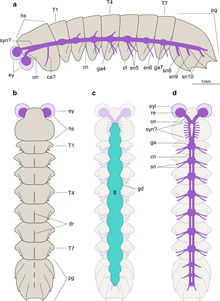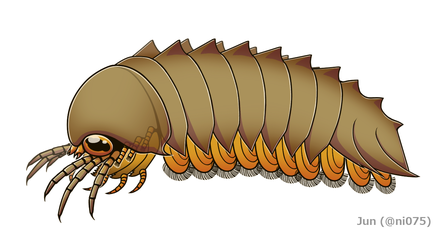Mollisonia
| Mollisonia Temporal range: | |
|---|---|

| |
| Reconstruction of Mollisonia plenovenatrix | |
| Scientific classification | |
| Domain: | Eukaryota |
| Kingdom: | Animalia |
| Phylum: | Arthropoda |
| Subphylum: | Chelicerata |
| Order: | †Mollisoniida |
| Family: | †Mollisoniidae |
| Genus: | †Mollisonia Walcott, 1912 |
| Type species | |
| †Mollisonia symmetrica Walcott, 1912 | |
| Species | |
| |
| Synonyms | |
|
Houghtonites Raymond, 1931 | |
Mollisonia is an extinct genus of Cambrian arthropod. 4 species had been described from North America and China. Studies suggest it is a basal member of Chelicerata, a group which includes horseshoe crabs and arachnids.[1][2]
Description

- Reconstruction of Mollisonia plenovenatrix in lateral wiew
The genus is characterized by a capsule-like dorsal exoskeleton (tergites), which was divided into a subequal size of cephalon and pygidium with 7 thoracic segments in between. Below the cephalon was a pair of huge compound eyes, followed by a series of walking legs and gnathobasic (jaw-like) limbs, each have 3 pairs in total. As a Cambrian arthropod, the genus is significant by bearing several traits of now-surviving chelicerates, such as pincer-like mouthparts (chelicerae) and fused ring-like cephalic nerves (synganglion) within their head, as well as a series of multilayered book gills underneath their trunk appendages.[1][2]
Mollisonia may had been a benthic predator, using its anterior chelicerae and posterior gnathobasic limbs to devour prey items while using the 6 legs to walk around the sea floor. The gill-bearing trunk appendages may had been solely for breathing. This functional differentiation (head/prosomal appendages for feeding and walking, trunk/opisthosomal appendages for breathing) is closer to euchelicerates (crown-group chelicerates other than sea spiders) than the basal chelicerate genera of Habeliida (e.g. Habelia, Sanctacaris).[1]
Distribution and taxonomy
Three species (P. symmetrica, P. gracilis, P. plenovenatrix) are known from the Burgess Shale, with 21 specimens are known from the Greater Phyllopod bed, where they comprise less than 0.1% of the community as of 2006.[3] The genus is also known from Langston Formation, and Wheeler Shale of North America, as well as Chengjiang Biota of China (P. sinica).[4] Remains possibly attributable to the genus are also known from the Ordovician Fezouata Formation of Morocco and Bøggild Fjord Formation in Greenland.[5]
The taxonomic affinity of this genus was enigmatic until the discovery of its chelicerate features in 2019.[1] Subsequent studies suggest it is a basal chelicerate, closer to crown-group Euchelicerata than members of Habeliida. It is also suggested to be closely related to Corcorania, Urokodia (formerly[6]), and Thelxiope, which together form the order Mollisoniida.[1]
See also
References
- ^ a b c d e Aria, Cédric; Caron, Jean-Bernard (September 2019). "A middle Cambrian arthropod with chelicerae and proto-book gills". Nature. 573 (7775): 586–589. Bibcode:2019Natur.573..586A. doi:10.1038/s41586-019-1525-4. ISSN 0028-0836. PMID 31511691. S2CID 202550431.
- ^ a b Ortega-Hernández, Javier; Lerosey-Aubril, Rudy; Losso, Sarah R.; Weaver, James C. (2022-01-20). "Neuroanatomy in a middle Cambrian mollisoniid and the ancestral nervous system organization of chelicerates". Nature Communications. 13 (1): 410. doi:10.1038/s41467-022-28054-9. ISSN 2041-1723. PMC 8776822.
- ^ Caron, Jean-Bernard; Jackson, Donald A. (October 2006). "Taphonomy of the Greater Phyllopod Bed community, Burgess Shale". PALAIOS. 21 (5): 451–65. Bibcode:2006Palai..21..451C. doi:10.2110/palo.2003.P05-070R. JSTOR 20173022. S2CID 53646959.
- ^ Zhang, Xingliang; Zhao, Yuanlong; Yang, Ruidong; Shu, Degan (November 2002). "The Burgess Shale arthropod Mollisonia (M. sinica new species): new occurrence from the Middle Cambrian Kaili fauna of southwest China". Journal of Paleontology. 76 (6): 1106–1108. Bibcode:2002JPal...76.1106Z. doi:10.1017/S0022336000057917. ISSN 0022-3360. S2CID 130112985.
- ^ Peel, John S.; Willman, Sebastian; Pedersen, Stig A. Schack (March 2020). "Unusual preservation of an Ordovician (Floian) arthropod from Peary Land, North Greenland (Laurentia)". PalZ. 94 (1): 41–51. doi:10.1007/s12542-019-00481-y. ISSN 0031-0220.
- ^ Liu, Cong; Fu, Dongjing; Wu, Yu; Zhang, Xingliang (July 2024). "Cambrian euarthropod Urokodia aequalis sheds light on the origin of Artiopoda body plan". iScience: 110443. doi:10.1016/j.isci.2024.110443. PMC 11325232.
External links
- "Mollisonia symmetrica". Burgess Shale Fossil Gallery. Virtual Museum of Canada. 2011. Archived from the original on 2020-11-12.

